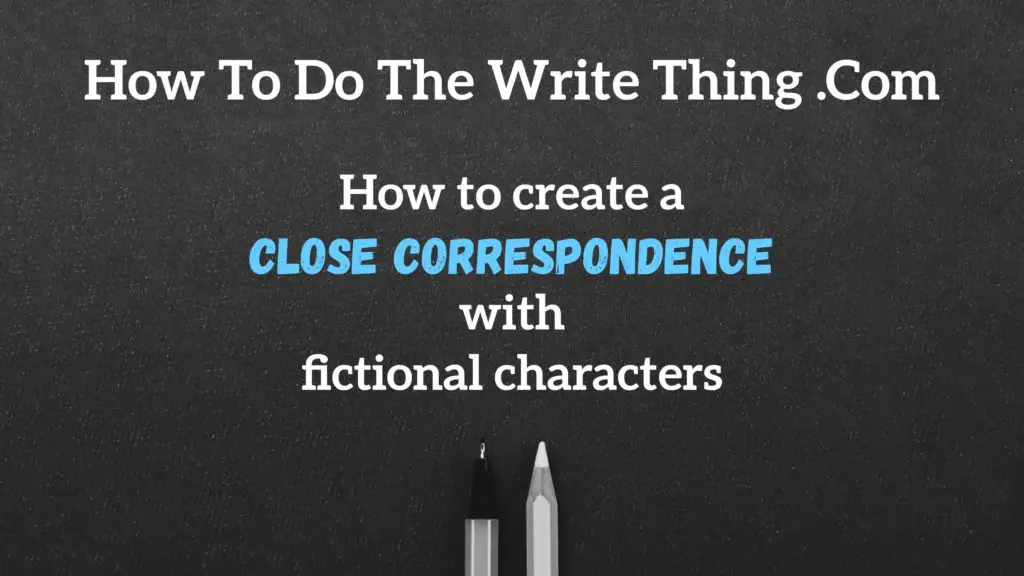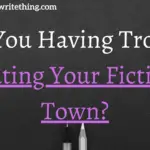When creating close relationships with fictional characters, their dialogue matters immensely. Their dialogue shows their true heart and reveals a lot about their character.

How to create a close correspondence with fictional characters
Not all stories must have multiple characters.
But for the stories that do you must consider how to make your characters’ correspondence make sense.
Character correspondence helps define their relationships and how they interact and deal with each other. Their correspondence will shape them in the imagination of your reader.
It will play a key role in who the character is as a person and their worldview.
Not all of your character’s correspondence will be evident at the beginning of their story. Most interactions and conversations will happen after the reader meets the character and your reader will get to go on that journey with them. Some will happen in their past and therefore will be in flashbacks.
Depending on what you choose as the writer will immediately affect how your reader perceives your character and their past and present experiences.
Interested in starting a blog of your own? Check out Bluehost.
If you enjoy Creating Close Correspondence with Fictional Characters and writing fiction, you might love owning a domain of your own where you can write about it? Ever want to own your own domain name (Yourname.com)?
Bluehost hosts your blog so that you can own your domain and make money blogging. Check them out only if you’re interested in making money blogging; otherwise, go for a free blog instead 🙂
Try Grammarly, The Free tool that should be in every writer’s toolbelt.
How to create a close correspondence with fictional characters:
1. Romantic correspondence with fictional characters
Does your character have a love interest?
Are they dating?
Are they married?
Are they stalking someone?
Are they making plans to woo said strumpet?
Do they have an ex?
Do they have exes?
Will you introduce them to the love of their life?
Or will you introduce them to a short turbulent relationship?
Asking questions like these will help you think through what their key romantic correspondences are.
Interested in starting a blog of your own? Check out Bluehost.
If you enjoy Creating Close Correspondence with Fictional Characters and writing fiction, you might love owning a domain of your own where you can write about it? Ever want to own your own domain name (Yourname.com)?
Bluehost hosts your blog so that you can own your domain and make money blogging. Check them out only if you’re interested in making money blogging; otherwise, go for a free blog instead 🙂
Try Grammarly, The Free tool that should be in every writer’s toolbelt.
How to create a close correspondence with fictional characters:
2. How do they view friendship?
Are they naive?
Do their peers take advantage of them?
Are they lonely?
Are they the class clown?
Do they have lots of people they call friends?
Are they a hermit?
Do they have one main close friend?
Are they jealous of others’ friendships?
Are they secretly jealous of their friend’s popularity?
Do they have a secretly jealous friend?
Do they have friends that use them?
Or do they have friends that support them?
Interested in starting a blog of your own? Check out Bluehost.
If you enjoy Creating Close Correspondence with Fictional Characters and writing fiction, you might love owning a domain of your own where you can write about it? Ever want to own your own domain name (Yourname.com)?
Bluehost hosts your blog so that you can own your domain and make money blogging. Check them out only if you’re interested in making money blogging; otherwise, go for a free blog instead 🙂
Try Grammarly, The Free tool that should be in every writer’s toolbelt.
How to create a close correspondence with fictional characters:
3. Family
Do they have in-laws?
Do they have siblings?
Do they have a mother in their life?
Do they have a father in their life?
Do they have a kind family?
Or do they have a lot of family drama?
Think about these questions and answer them to help create more dynamic conversations and relationships for your characters.
Take action:
Try to come up with more questions on your own about how your character converses with:
- Strangers
- Acquaintances
- Fans
- People they find annoying
- People that intimidate them
- People they are mad at
Interested in starting a blog of your own? Check out Bluehost.
If you enjoy Creating Close Correspondence with Fictional Characters and writing fiction, you might love owning a domain of your own where you can write about it? Ever want to own your own domain name (Yourname.com)?
Bluehost hosts your blog so that you can own your domain and make money blogging. Check them out only if you’re interested in making money blogging; otherwise, go for a free blog instead 🙂
Try Grammarly, The Free tool that should be in every writer’s toolbelt.
By doing creative thinking exercises like these we can really add value to our characters, their social interactions, and their relationships.
I hope these questions have helped you think through more ways to enrich your fictional characters’ dialogue and relationships with other characters.
Hope this helps!
Happy Writing 🙂
Other Popular Posts you might just love to slice through:
5 Tricks How to Hide Your Villain Right Before Their Eyes
How To Write 4 Scenes That Reveal Who Your Character Is Seamlessly
4 Tips How to Write your Character Hitting Rock Bottom
How to create a close correspondence between fictional characters

Make sure your posts are readable. Use this readability score check
Interested in starting a blog of your own? Check out Bluehost.
If you enjoy Creating Close Correspondence with Fictional Characters and writing fiction, you might love owning a domain of your own where you can write about it? Ever want to own your own domain name (Yourname.com)?
Bluehost hosts your blog so that you can own your domain and make money blogging. Check them out only if you’re interested in making money blogging; otherwise, go for a free blog instead 🙂
Try Grammarly, The Free tool that should be in every writer’s toolbelt.
We hope you enjoyed: How to Create a Close Correspondence Between Fictional Characters




